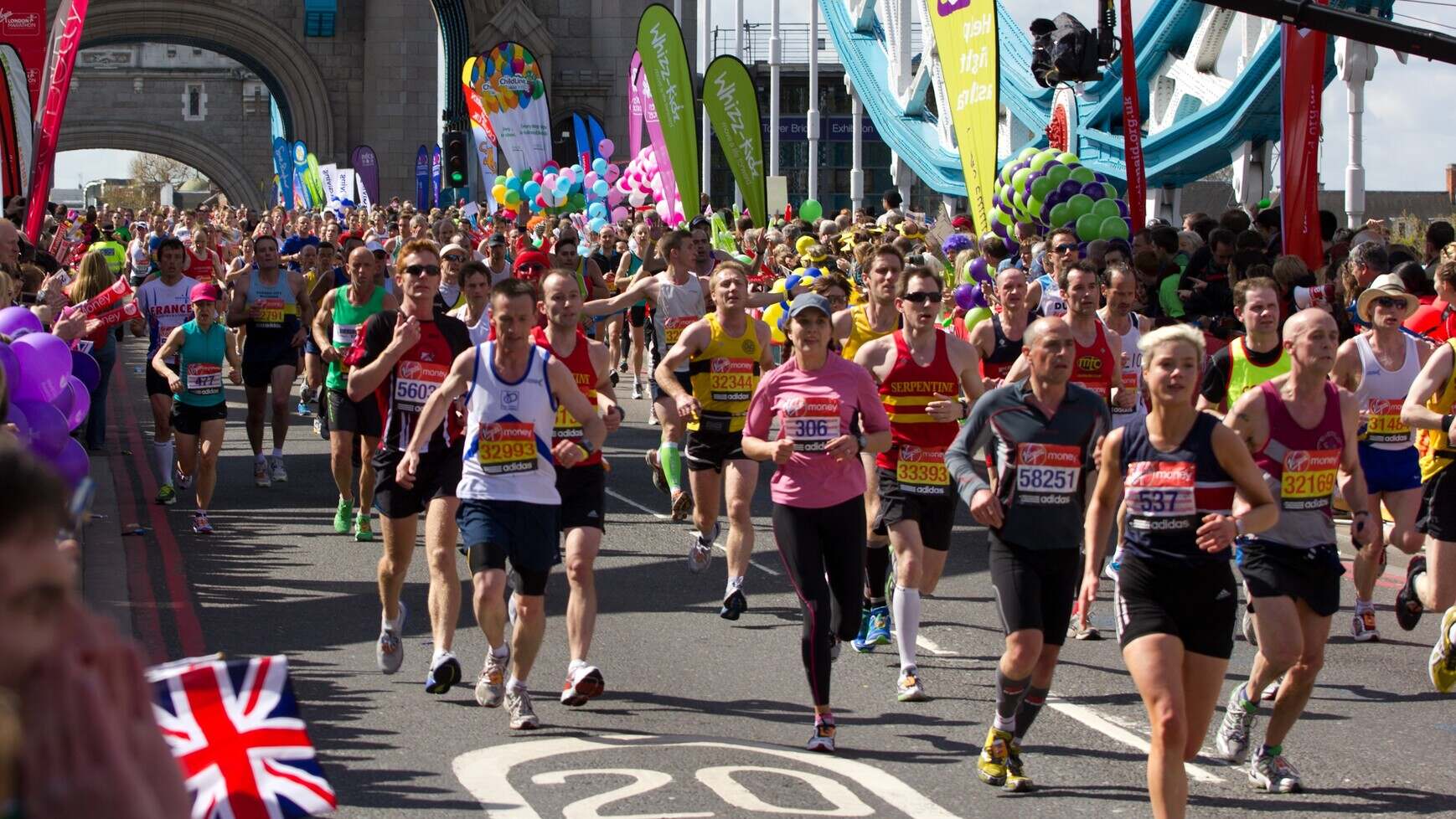Home>Misc>Featured>How To Compare Times Of Different Distance Running Equations


Featured
How To Compare Times Of Different Distance Running Equations
Modified: January 2, 2024
Learn how to compare running times for different distances with featured equations. Gain insights on how to analyze and evaluate performance in various race formats.
Introduction
Distance running is a popular sport that attracts athletes of all levels, from beginners to elite competitors. Whether you’re training for a marathon, planning a race strategy, or simply curious about how different running distances compare in terms of time, understanding how to compare times of different distance running equations is essential.
Comparing times between different race distances can provide valuable insights into your performance and help you set realistic goals. It can also assist in race planning and pacing strategies. However, due to the varying factors involved, such as pace, terrain, and individual fitness levels, comparing times accurately can be challenging.
In this article, we will explore different methods and tools that can be used to compare times between different distance running equations. We will discuss common conversion factors, proportions and ratios, pace calculators and converters, as well as performance charts and tables. By understanding these methods and utilizing the appropriate tools, you can make more informed decisions and better evaluate your running performance.
It is important to note that these methods provide approximate comparisons and should be used as guidelines. Each runner is unique, and individual performance can be influenced by various factors, such as training, genetics, and race conditions. It is always best to consult with a coach or experienced runner for personalized advice.
Now, let’s delve into the details of understanding distance running equations and the factors to consider when comparing times.
Understanding Distance Running Equations
Distance running equations are mathematical formulas that relate distance, time, and pace. They allow us to quantify and compare running performances across different race distances. To fully grasp how these equations work, let’s break down some key components:
Distance: The distance of a race is typically measured in miles or kilometers. It represents the total length of the course that runners will cover during the race.
Time: Time refers to the duration it takes to complete a race. It is usually recorded in hours, minutes, and seconds. Timing systems, such as chip timing or manual stopwatch, accurately capture a runner’s finishing time.
Pace: Pace is the speed at which a runner covers a specific distance. It is often calculated as the time taken to run a mile or kilometer. For example, a runner with a pace of 8 minutes per mile completes each mile in 8 minutes.
Understanding these components helps us comprehend how different race distances can be compared. To compare times between different distance running equations, it’s crucial to consider the relationship between distance, time, and pace.
For instance, if you have completed a 10-kilometer race in 50 minutes, you can use this information to estimate your time for a half-marathon (21.1 kilometers) by applying distance running equations. By knowing your pace for the 10-kilometer race, you can determine an estimated finishing time for the half-marathon.
Furthermore, understanding distance running equations allows you to evaluate your overall running performance and progress over time. You can track improvements in your pace or calculate your estimated finishing times for future races based on your current performance.
Now that we have a clear understanding of distance running equations, let’s explore the factors to consider when comparing times between different race distances.
Factors to Consider When Comparing Times
When comparing times between different race distances, it’s important to consider various factors that can impact running performance. These factors help provide a more accurate and meaningful comparison. Here are some key factors to keep in mind:
- Pace Variations: Different race distances often require different pacing strategies. For instance, shorter races like 5Ks or 10Ks may be run at a faster pace compared to longer distances like marathons. Pacing variations need to be considered when comparing times between different race distances.
- Terrain and Elevation: The terrain and elevation of a race course can significantly affect running performance. Uphill or downhill sections can impact pace and, subsequently, time. When comparing times, it’s essential to consider the elevation changes and terrain conditions of both races.
- Weather Conditions: Weather, including temperature, humidity, and wind, can affect running performance. Running in extreme heat or cold can slow down your pace and impact race times. When comparing times, it’s helpful to take into account the weather conditions for each race.
- Training and Fitness Level: The level of training and fitness at the time of each race can influence time comparisons. A runner who is more experienced or has undergone specific training for a particular distance may perform differently compared to someone who is relatively new to running or hasn’t focused on that distance. Take into consideration the training and fitness level for accurate time comparisons.
- Individual Differences: Every runner is unique, and factors such as age, genetics, and overall health can impact performance. It’s crucial to remember that comparing times between different individuals may not always provide an accurate representation. To make a fair comparison, focus on your own performance and progress.
Considering these factors when comparing times will assist in making a more informed assessment. It’s important to note that while these factors affect performance, they should not discourage you from comparing times or setting goals. Time comparisons can provide valuable insights and motivation for personal improvement.
Now that we have discussed the factors to consider, let’s explore different methods and tools that can be used to compare times between different distance running equations.
Method 1: Using Common Conversion Factors
One method to compare times between different distance running equations is by using common conversion factors. These factors allow you to estimate your performance in one race distance based on your time in another. Here’s how you can use this method:
- Identify the race distances: Determine the two race distances you want to compare. For example, you may want to compare your 10K time to a half marathon.
- Convert the distances: Use conversion factors to convert the race distances into a common unit, such as miles or kilometers. For example, if the 10K race is in kilometers, convert it to miles using a conversion factor of 0.621371.
- Apply the conversion: Divide your time in the first race distance by the ratio of the converted distances. This will give you an estimated time for the second race distance.
For example, let’s say you completed a 10K race in 50 minutes and you want to estimate your time for a half marathon. Assuming the half marathon is equivalent to 13.1 miles, you would divide your 10K time (50 minutes) by the ratio of the converted distances (10K in miles/13.1 miles). This would give you an estimated time for the half marathon.
It’s important to note that this method provides an approximate estimation and may not account for variables such as pacing variations or terrain differences between the two race distances. However, it can serve as a starting point for setting goals and planning training.
Using common conversion factors is a simple and convenient method to compare times between different distance running equations. However, for more accurate estimations, other methods and tools can be utilized, which we’ll explore in the following sections.
Method 2: Applying Proportions and Ratios
Another effective method to compare times between different distance running equations is by applying proportions and ratios. This method allows you to establish a relationship between the two race distances and use it to estimate your time. Here’s how you can use this method:
- Identify the known and unknown race distances: Determine which race distance you have a known time for and which distance you want to estimate your time for. For example, you may have completed a 5-mile race and want to estimate your time for a 10-mile race.
- Establish the ratio of the distances: Determine the ratio between the known and unknown race distances. In this example, the ratio would be 5 miles (known distance) to 10 miles (unknown distance), which simplifies to 1:2.
- Apply the ratio to your known time: Multiply your known time by the ratio established in the previous step. This will give you an estimated time for the unknown race distance. Using the example, if your known time for the 5-mile race is 40 minutes, multiplying it by the ratio of 1:2 would give you an estimated time of 80 minutes for the 10-mile race.
Applying proportions and ratios allows you to create a proportional relationship between the two race distances. By utilizing the known time and the established ratio, you can estimate your performance in the unknown race distance.
It’s important to note that this method is based on the assumption that you will maintain a similar pace and effort level between the known and unknown race distances. Factors such as pacing variations and terrain differences may affect your actual performance. Nevertheless, applying proportions and ratios can provide a useful estimation and assist in goal setting and race planning.
Now that we’ve explored the second method, let’s move on to the next method: utilizing pace calculators and converters.
Method 3: Utilizing Pace Calculators and Converters
Utilizing pace calculators and converters is another method to compare times between different distance running equations. These tools allow you to input a known time for a specific distance and receive estimated times for other distances based on your pace. Here’s how you can use this method:
- Locate a reliable pace calculator or converter: There are various online tools and mobile apps available that provide pace calculators and converters. Choose a reputable and user-friendly option.
- Input your known time and distance: Enter your known race time and distance into the pace calculator or converter. For example, if you completed a 10K race in 45 minutes, enter that information into the tool.
- Select the desired distance: Choose the race distance you want to compare your time to. The tool will then calculate the estimated time based on your pace.
The pace calculator or converter utilizes your known time and distance to estimate your pace per mile or kilometer. It then applies this pace to the selected distance to calculate the estimated time. This method takes into account factors such as pace variations and is especially helpful when comparing times for specific distances.
Using pace calculators and converters provides a more accurate estimation by incorporating your actual pace. It eliminates the need for manual calculations or assumptions and offers a convenient tool to compare times for different race distances.
Keep in mind that these tools may have slight variations in calculation algorithms, so it’s beneficial to try different pace calculators or converters for a more comprehensive analysis.
Now that we’ve explored the third method, let’s move on to the next method: using performance charts and tables.
Method 4: Using Performance Charts and Tables
Using performance charts and tables is an additional method to compare times between different distance running equations. These resources provide a comprehensive overview of average finish times for various race distances and can be highly useful for estimating your performance. Here’s how you can use this method:
- Access performance charts or tables: Look for performance charts or tables specific to your target race distance or running level. They can often be found in running magazines, training books, or online platforms.
- Locate your known race distance: Look for the race distance you have a known time for in the performance chart or table. Identify the corresponding average finish time for that distance.
- Compare average finish times: Locate the race distance you want to estimate your time for and refer to the average finish time provided in the chart or table. Compare it to your known time to get an estimation.
Performance charts and tables provide a valuable reference point by showing the average finish times of runners at different distances. They take into account the performances of a wide range of runners, including recreational runners and elite athletes. This method can give you a more realistic estimation and help set goals for your target race distance.
It’s important to note that these charts and tables are based on average performances and may not reflect individual variations or specific race conditions. Factors such as terrain, weather, and personal fitness level should be considered when interpreting the data.
While performance charts and tables provide a general guideline, always remember that your own training, preparation, and dedication play a significant role in your running performance. Use these resources as a reference to help you assess and compare your times between different race distances.
Now that we’ve explored the four methods of comparing times, let’s consider some limitations and considerations.
Limitations and Considerations
While comparing times between different distance running equations can be helpful for setting goals and evaluating performance, it’s important to be aware of the limitations and considerations involved. Here are some factors to keep in mind:
- Individual Variations: Every runner is unique, and various factors such as training background, genetic predisposition, and physical condition can influence performance. It’s essential to understand that comparisons should be made within the context of your own progress and not solely rely on general guidelines or comparisons with others.
- Environmental Factors: Race conditions, such as terrain, weather, and altitude, can have a significant impact on running performance. It’s essential to consider these factors when comparing times, as they can affect your pace and overall race experience.
- Pacing Strategies: Different race distances often require different pacing strategies. Shorter distances may be run at a faster pace, while longer distances require more endurance and pacing control. When comparing times, it’s important to consider the pacing variations between the distances you are comparing.
- Training and Preparation: The level of training and preparation for a specific race distance plays a crucial role in performance. Comparing times between distances without considering the level of training can lead to inaccurate estimations. Ensure that you have properly trained for the race distance you want to compare your time to.
- Non-linear Progression: Improvements in running performance often do not follow a linear progression, especially as runners reach higher fitness levels. It’s important to recognize that as your running abilities develop, achieving the same percentage improvement across different distances may become more challenging.
Additionally, it’s worth noting that while the methods discussed in this article can provide estimations and rough comparisons, they are not foolproof. They serve as useful tools but should not be the sole determinant of your running goals or expectations.
It’s always recommended to consult with experienced coaches or trainers who can offer personalized guidance based on your specific abilities, goals, and race conditions. They can provide invaluable insights and help you make more informed decisions about your training and performance comparisons.
By considering these limitations and understanding the various factors at play, you can make more realistic and meaningful comparisons between different distance running equations.
Now that we’ve explored the limitations and considerations, we can conclude our discussion on comparing times between different race distances.
Conclusion
Comparing times between different distance running equations can be a valuable tool for assessing performance, setting goals, and planning races. By understanding the methods and tools available, such as common conversion factors, proportions and ratios, pace calculators and converters, and performance charts and tables, you can make more informed comparisons and estimations.
However, it’s important to keep in mind the limitations and considerations involved. Individual variations, environmental factors, pacing strategies, training and preparation, and non-linear progression all play a role in running performance and should be considered when comparing times.
While these methods provide a rough estimation, they should not be the sole determinant of your running goals or expectations. It’s essential to personalize your approach, seek guidance from experienced individuals, and consider your own progress and unique circumstances.
Remember that each step forward in your running journey, regardless of the distance or time, is an achievement to be celebrated. The joy and fulfillment of running come from the personal growth and dedication you invest in the sport.
So, whether you’re training for a 5K, 10K, half marathon, or marathon, embrace the process, challenge yourself, and enjoy the journey. Use time comparisons as a guide, but always focus on your own progress and the passion that fuels your love for distance running.
Now armed with the knowledge of these methods and considerations, you’re ready to evaluate and compare your times with confidence and make informed decisions to reach new heights in your distance running pursuits.








